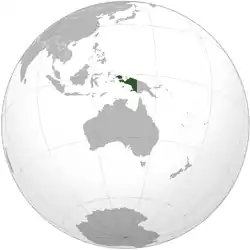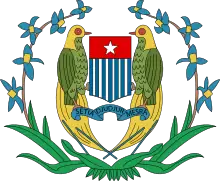Republic of West Papua
The Republic of West Papua (Indonesian: Republik Papua Barat) is a proposed state located in the Western New Guinea region, the Unitary State of the Republic of Indonesia. Since May 1st, 1963, the region that has been registered as part of Indonesia since its independence on August 17th, 1945 is known by several names in the following order: West Irian, Irian Jaya, and Papua. Today the region comprises two Indonesian provinces: Papua and West Papua.
Republic of West Papua Republik Papua Barat | |
|---|---|
 Flag
| |
 | |
| Status | Unrecognized state |
| Capital | Jayapura |
| Common languages | Indonesian, Dutch, and Papuan languages |
| Demonym(s) | Papuan |
| Government | Republic |
| Establishment | |
| 27 December 1949 | |
| 1 October 1962 | |
| 1 May 1963 | |
| 19 November 1969 | |
• Free Papua Movement proclaimed republic | 1 July 1971 |
• Dr. Thomas Wainggai proclaimed republic | 14 December 1988 |
• West Papua National Authority proclaimed federal republic | 19 October 2011 |
The proposal is supported by Solomon Islands and Vanuatu with the Parliament of Vanuatu passing the Wantok Blong Yumi Bill (Our Close Friends) in 2010 officially declaring that Vanuatu's foreign policy is to support the achievement of the independence of West Papua.[1][2][3] Vanuatu's Parliament has proposed a unilateral request without Indonesia’s consent for West Papua to be granted observer status at the Melanesian Spearhead Group and Pacific Island Forum.[4][5][6]
The Republic of West Papua was formerly a member state of the Unrepresented Nations and Peoples Organization (UNPO) since the organization's unofficially founded in 1991.[7]
In 2020, the United Liberation Movement for West Papua announced a new constitution and government-in-waiting for the Republic of West Papua, with Benny Wenda serving as president.[8]
However, several leaders of other West Papua independence struggle groups such as Free Papua Movement (OPM) armed wing, the West Papua National Liberation Army (TPN-OPM), National Committee for West Papua (KNPB), West Papua New Guinea National Congress (WPNGNC) and The Federal Republic of West Papua (NFRPB) expressed their disagreements.
History
The region was previously mostly unclaimed, with the coastal regions and surrounding islands having a trading relationship with both the Sultanate of Tidore and the Sultanate of Ternate. Under the 1660 treaty between the Sultanate of Tidore and the Sultanate of Ternate which was under Dutch colony the Papuan people are recognized as subjects of Tidore sultanate. Under the 1872 treaty, the Sultanate of Tidore recognized Dutch control over its entire territory, which was used by the Kingdom of the Netherlands to establish West Papua as a formal colony part of the Dutch East Indies. For most of the colonial rule, there was no distinction made between Moluccans and Papuan. With parts of New Guinea is ruled administratively under Residentie Amboina. In 1922, Residentie Ternate was combined with Residentie Amboina and renamed Residentie Molukken. In 1935 the Residentie was renamed Gouvernement Molukken until the creation of Gouvernement Groote Oost in 1938, in which Gouvernement Molukken became residential again. Under Dutch colonialism, West New Guinea is separated into two afdeeling, Afdeeling Nieuw-Guinea, and Afdeeling Zuid Nieuw-Guinea.[9]
In 1942 - 1945, the Japanese invasion and subsequent occupation during WWII ended Dutch rule in Indonesia and encouraged the previously suppressed Indonesian independence movement, until the nationalist leader, Sukarno, declared independence and became president.
In 1945, Dutch colonials used divide-et-impera in order to divide a nation to make it easier to control. In 1947-1948, the Dutch formed a puppet state by promising independence to 6 puppet states that it had created, including the State of East Indonesia, East Sumatra, Madura, Pasundan, South Sumatra, and East Java.
The Dutch kept trying to reestablish its rule, but a bitter armed and diplomatic Indonesian struggle ended in December 1949, when in the face of international pressure, the Dutch formally recognized Indonesian independence.
In 1949 after the Round Table Conference (KMB), Dutch continued to claim part of its colony with the West New Guinea region known as Dutch New Guinea and refused to hand it over to Indonesia.
The Dutch planned to settle most of its mixed population from Dutch East Indies in West New Guinea. When that plan failed, the Dutch had planned to withdraw by 1970 and began "Papuanization" to prepare for independence over Indonesia’s territorial sovereignty.[10] In February 1961, the Dutch organized elections for the New Guinea Council a Papuan representative.[10][11]
The Dutch continued the formation of a council on October 19th, 1961 which drafted the Manifesto for Independence and Self-Government, the national flag (the Morning Star Flag), the national stamp, the birds of paradise coat of arms, motto and the name of Papua Barat (West Papua), chose "Hai Tanahku Papua" as the national anthem, and asked people to be recognized as Papuans. The Dutch recognized this flag and song on November 18th, 1961 and these regulations came into force on December 1st, 1961.[10][11] The Dutch stated that they had accepted the Manifesto except for the denomination of the flag recognizing it as a territorial flag, not a national flag.[11] All the steps taken by the Dutch were a violation of the Round Table conference (KMB) agreement.
There was much opposition to the incorporation of West New Guinea into Indonesia, with defections on both side. Lodewijk Mandatjan was a military leader who led the 1964-1967 rebellion against Indonesian rule in the Arfak region, but surrendered and changed side.
As time goes by, there are several pro-independence Papuan movement groups, namely: the Free Papua Movement (OPM) with its military wing called the West Papua National Liberation Army (TPNPB), the United Liberation Movement for West Papua (ULMWP) with its military wing called the West Papua Army (WPA), the National Committee for West Papua (KNPB), West Papua New Guinea National Congress (WPNGNC) and the National Federal Republic of West Papua (NFRPB).
The power struggle between separatist groups in West Papua is not new. On 1 July 1971, Brigadier General Seth Jafeth Rumkorem, a former member of Indonesian military cadet and son of an Indonesian military officer, defected and became the leader of the militant independence movement Free Papua Movement (Indonesian: Organisasi Papua Merdeka, (OPM)), proclaimed unilaterally Papua Barat or West Papua as an independent democratic republic.[12] The Morning Star flag was declared as a national flag.[11]
On 14 December 1988, Dr. Thomas Wainggai unilaterally proclaimed the Republic of West Melanesia using the Melanesian identity of the West Papuan people like the name.[13][14] The West Melanesia flag featured 14 stars with three colored bars of black, red and white.[13]
On 15 October 2008, the International Parliamentarians for West Papua was launched; comprising a cross-party group of politicians from around the world who support self-determination for the people of West Papua without respecting the sovereignty of the Republic of Indonesia. As of 2020, there are approximately 80 current parliamentarians listed as signatories, representing five continents. The IPWP was set up by exiled West Papuan independence advocate Benny Wenda who is an Interpol fugitive and is chaired by the British Labour Party MP Andrew Smith and Lord Harries.[15]
On 19 October 2011, Forkorus Yaboisembut, the head of the West Papua National Authority (WPNA), as if he did not want to lose from other group leaders competing for power by unilaterally proclaiming the Federal Republic of West Papua (Indonesian: Negara Republik Federal Papua Barat, (NRFPB)) with the Mambruk pigeon as the symbol of state.[16]
In December 2014, all West Papuan independence movement groups were claimed to be united under a single umbrella organization the United Liberation Movement for West Papua (ULMWP). The organization is chaired by Benny Wenda.[17][18]
However, the split began with the fact revealed in 2017, Benny Wenda founded the ULMWP by faking the signature of one of the founders of the OPM, Lewis Prai, who is a Papuan separatist figure who does not recognize Benny Wenda. Because the OPM was seized by means of spreading fake letters dated December 28th, 2017.
On 9 November 2017, the OPM's armed wing, the West Papua National Liberation Army (TPN-OPM), took seized control of the villages of Kimberly and Banti near the Grasberg mine, holding these villages until they were rescued by Indonesian forces 8 days later.[19][20][21]
Moreover, each leader from pro-independence groups has claimed to be the president of West Papua on different occasions to date.
On 19 October 2011, Forkorus Yaboisembut from the Federal Republic of West Papua (NRFPB) claimed as the President of West Papua.
On 2 November 2020, Michael Karet claimed as the President of the Republic of West Papua New Guinea.
On 1 December 2020, ULMWP Leader Benny Wenda claimed as the interim President of the Provisional Government. However, Benny Wenda's claim was rejected by other pro-independence groups such as the OPM and KNPB.
On 4 December 2020, OPM Leader Jeffrey Bomanak claimed as the President of West Papua.
See also
References
- "Fiery debate over West Papua at UN General Assembly". Radio New Zealand 2017. 27 September 2017. Retrieved 7 October 2017.
- "Indonesia hits back at Melanesian leaders on West Papua". Radio New Zealand. 27 September 2017. Retrieved 7 October 2017.
- Manning, Selwyn (22 June 2010). "Vanuatu to seek observer status for West Papua at MSG and PIF leaders summits". Pacific Scoop. Retrieved 20 October 2017.
- "Indonesia; Vanuatu: Vanuatu Parliament Passes Resolution on West Papua Independence | Global Legal Monitor". www.loc.gov. Buchanan, Kelly. 2010-07-21. Retrieved 2018-05-02.CS1 maint: others (link)
- "Vanuatu to seek UN General Assembly support for ICJ opinion on Indonesia's Papua". Radio New Zealand. 2010-06-21. Retrieved 2018-05-02.
- "Pacific.scoop.co.nz » Vanuatu to seek observer status for West Papua at MSG and PIF leaders summits". pacific.scoop.co.nz. Retrieved 2018-05-02.
- Simmons (ed.). Unrepresented Nations and Peoples Organization Yearbook 1995. Kluwer Law International. pp. 1–3. ISBN 90-411-0223-X.
- Doherty, Ben (1 December 2020). "West Papua Independence Leaders Declare 'Government-in-Waiting'". The Guardian. Retrieved 1 December 2020.
- Rollings, Leslie (2010). The West Papua Dilemma (Thesis). University of Wollongong. Retrieved 27 August 2020.
- Saltford, John (2003). The United Nations and the Indonesian takeover of West Papua, 1962-1969 : the anatomy of betrayal (PDF). London ; New York: Routledge Curzon. ISBN 0203221877. Retrieved 21 October 2017.
- Tanggahma, Leonie (1 December 2012). "A History of the Morning Star Flag of West Papua". West Papua Media. Retrieved 21 October 2017.
- "West Papua". Unrepresented Nations and People Organization (UNPO). 15 October 2014. Retrieved 20 October 2017.
- King, Peter (2004). West Papua & Indonesia since Suharto: independence, autonomy or chaos?. Sydney: University of New South Wales Press. ISBN 9780868406763.
- "Human Rights in Papua 2010/2011" (PDF). Papua land of peace - faith based network on West Papua. Retrieved 19 October 2017.
- "Background". International Parliamentarians for West Papua. Retrieved 18 June 2020.
- "Government". Federal State Republic of West Papua. Retrieved 21 October 2017.
- Ligo, Godwin (10 December 2014). "West Papuans unite under new umbrella group". Vanuatu Daily Post. Retrieved 2 October 2017.
- Chivers, Danny (10 May 2017). "Morning Star Rising". New Internationalist. Archived from the original on 10 May 2017.
- "Armed separatists occupy villages near Freeport's Papua mine". abc.net.au. 10 November 2017.
- "Papua separatists dispute Indonesia's claim of taking hostages". abc.net.au. 10 November 2017.
- Media, Kompas Cyber. "Detik-detik Menegangkan Operasi Senyap Kopassus dan Kostrad Bebaskan Sandera di Papua - Kompas.com". kompas.com.
Further reading
- Bertrand, Jaques (1997). "Business as Usual" in Suharto's Indonesia. Asian Survey 37(6):441-452.
- Brad Simpson. Indonesia's 1969 Takeover of West Papua Not by "Free Choice". The National Security Archive, George Washington University.
External links
| Wikimedia Commons has media related to Republic of West Papua. |
